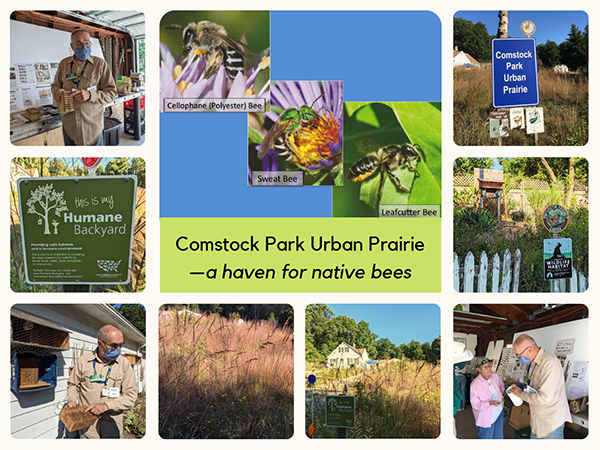KEITH EDWARDS—STEWARD TO BEES
at Comstock Park Urban Prairie
Recap of September 18 Walkabout by Marti MacArthur, WORC President

It was a clear, blue sky day and the perfect day to enjoy a visit to a remarkable yard. Keith Edwards has researched the type of plants that were growing in the area that is now his one acre of yard before Europeans came to this continent. It appears to have been a White Pine and White Oak landscape. He has now worked to include these trees on his property along with many different grasses and plants that thrive in a very sandy soil. To learn more about your area pre-settlement, go to the USDA Web Soil Survey website for instructions and then use Area of Interest Tab.
When we arrived we were invited into the garage where he had long tables of books and articles to examine. There were also many resources and posted information that he has used to research his property and to learn about the bees that he so loyally cares for throughout the year. Keith has studied and researched how to help bees survive and he has special boxes filled with empty tubes in which the different bees can place their small cocoons. He can identify which type of bee is using the tube that he has in the block holders that are hung in different areas of his yard and protected by chicken wire to keep out predators such as birds and other animals that would like to eat the bee larva.
Keith showed us the inside of the blocks with the larva inside. He pointed out how the Grass Carrying Wasps separate the larva in the tube with pieces of grass and that grass will stick out of the ends of the tube. This is in contrast to other bees that will use their sonic buzzing sound to help smooth the end of the tube so that the tube is sealed. At the end of the season Keith will open the tubes and separate the different larvae of the many different species of bees and wasps and put them in his designated refrigerator where he can insure that the temperature remains constant for the bees. In the Spring, he watches the temperatures and the availability of flowering shrubs and trees with nectar and pollen so that when he puts the larva into a special larger tube with a hole for them to fly out of when fully developed, their chances of survival are so much better than if they would have been left outside.

Keith’s yard has many certifications and he has signs posted so that it is clear what is happening in his yard. The Big and Little Bluestem grasses were so pretty and both were going to seed. Keith has placed markers where the ground nesting bees have a hole leading to a nest. Sixty percent of native bees nest in the ground. The way to distinguish a native ground nesting bee vs ground nesting hornets is by the numbers of bees you see going into the hole. Native bees will have one bee looking for the entrance whereas hornets will have many bees flying in and out and are very aggressive about anything coming to close to the nest.
There was one more fascinating feature in Keith’s yard, and that was the area where water flows along the side of his yard when it rains. Keith has created a rain garden in this area and planted water loving plants to help retain water in the ground instead of it flowing into the road. One of the posted pictures in the garage was of a map showing the drought of ground water that is moving from West to East across the United States. The warming climate along with the massive spaces of impervious structures is adversely affecting the ground water levels and this now also includes Michigan.
Needless to say, each and every person who was in attendance at the Walkabout learned new information that they will hopefully, put to use as they watch the bees and provide the plants that make the difference in the survival of the insects and pollinators with whom we live. Keith pointed out that if there was ONE thing that each of us could do to help the survival of the many insects bees, and birds that we need, it is LEAVE THE LEAVES! If you must rake them out of an area, make a bundle and wrap it in chicken wire and put it someplace out of the way. So many important insects, even moths, butterflies and fireflies need those leaves for their survival during the winter.
It was a valuable experience listening to Keith and being able to see firsthand all that he is doing to heal the earth in his yard Thank you Keith for sharing your knowledge and your yard with all who came to the Walkabout.
